Chadwick House Eaglemont
[Previous Page: Architecture of Harold Desbrowe-Annear Next page: Karori Chalet Mount Macedon]
Table of Contents
Desbrowe-Annear’s Chadwick House.
“I first became aware of the work of Harold Desbrowe-Annear around 1964 when, as a student of architecture at RMIT, our design class led by Kevin Borland visited Eaglemont to walk around Walter Burley Griffin’s Glenard Estate (Pholiota, c.1919–20; Griffin’s own house; and Lippincott house, 1917, from Griffin’s office) and the Mount Eagle Estate (Griffin’s Skipper house, 1928), along with the adjacent Eaglemont Estate, within which three Harold Desbrowe-Annear houses were built.
- Piqued by the exteriors of the Annear houses, my interest led me to read Robin Boyd’s Australia’s Home, in which he refers to Annear’s inventive approach, in particular within the field of domestic building, where “he saw the greatest scope for the inventiveness and love of gadgets which so filled his mind in his younger days. Every new commission for a house was an invitation to experiment with a new device for a window or a cupboard or a detail of construction.”
- Geoffrey Woodfall’s essay on Harold Desbrowe-Annear, “Documents on Australian Architecture”, published in Architecture in Australia in February 1967, further stimulated my interest in Annear, particularly the large number of published photographs of his projects. This work also reproduced construction details published originally in For Every Man His Home, coordinated by Annear in 1922.
|
|
|
Twenty years after my “discovery” of Annear and after a progression of renovations and additions to Victorian terrace houses in Carlton, followed by a restoration and upgrade of a large Edwardian timber villa in Fairfield, my wife Jane and I, sick of DIY projects, discussed the possibility of designing a new house for ourselves if we could find suitable land, with a provision that if one of Annear’s houses ever became available then we would attempt to acquire it.
- Amazingly, within a week of this discussion, we discovered that our favourite Annear house, one of the trio in The Eyrie, Eaglemont, was due to be auctioned shortly. This house was designed for Annear’s father-in-law, James Chadwick, in 1903 and is today referred to as the Chadwick house.
- Armed with our rose-tinted glasses, we attended an inspection in June 1988 and confirmed our desire to make it ours.
- The auction, attended by about four hundred people including many architects, was an incredibly charged affair. A close friend – a Queen’s Counsel at the time – took to the bidding war with relish, refusing to let the momentum get away from him. He finally submitted the winning bid – approximately 30 percent higher than our contemplated maximum. Nevertheless, it was obvious to him that we had to have the property.
 |
| Peter Crone outside his beloved Desbrowe-Annear home, Chadwick House in Eaglemont. |
Enthused by the house’s architectural, social and historic importance (but less enthused by our considerable mortgage) we embarked upon the amazing experience of restoration in November 1988.
- Most of the work (except for the plumbing and electrical works) has been carried out by Jane and myself.
- Our intention has been to thoroughly restore the fabric of the building in accordance with the principles of the Burra Charter, where, as faithfully as possible, new work is subtly identified from the original.
- Prior to carrying out the work, it became obvious that a detailed investigation of the entire structure and finishes needed to be undertaken – at the outset, we had dismissed most of the “improvements” to the building as careless vandalism, but further inquiry upgraded our detective work to a murder investigation.
Prior to settlement, I perused the Heidelberg Conservation Study written for the then City of Heidelberg in 1985.
- One statement within the study referred to the various external elements where the “overall picturesque disposition of elements have been borrowed from northern European 14th and 15th century styles.
- These are exemplified in the white roughcast and black-stained timbering (i.e. the black and white houses).” No reference was made to the Arts and Crafts movement.
- During a visit to the house, I observed that beneath some flaking white paint on the external roughcast render there was a hint of colour.
 |
| CHADWICK HOUSE SOHE 2008 |
As soon as we became the legal owners I proceeded to strip away small sections of the paint throughout the exterior.
- The half-timber battens of the exterior walls were indeed originally black, having many coats of coal-tar stain.
- My suspicions that the house was much more than “pseudo-Tudor” were confirmed by a highly regarded conservation architect, who determined from my scraping samples that the house colouring comprised a rich colour palette often found on English and North American Arts and Crafts houses, with the render matching Porter’s Boncote Suntan colour.
- The original colour of the windows’ external timberwork, the swagged ogee arches and slatted balustrading was identified as a rich cream-ochre colour.
- The horizontal double-bevelled weatherboards were a rich dark brown.
by Peter Crone Architects IN THE ARCHITECT’S WORDS
- Text Peter Crone (below all illustrations)
- Photography Peter Bennetts, Patrick Bingham-Hall
- Published in Architecture Australia May June 2009

Harold Desbrowe Annear’s Chadwick House.Stage 1
Chadwick house designed by Harold Desbrowe Annear in 1903, is the central house in a group of three designed by Annear, all of which benefit from Heritage Victoria registration, as well as National Trust classification.
Purchased by my wife and I in 1988, with an appreciation of its architectural,social and historical importance and with a considerable mortgage, we embarked upon its restoration,with the majority of the work being carried out by ourselves except for
contracting the electrical rewiring and plumbing works along with the manufacturing of specialised components.
Rich Colour palette
Initially our first task was to prove the local council heritage study was incorrect in asserting that the original house coloring was “black and white”, as an early observation of flaking paint on the roughcast render indicated a strong colour beneath.
 |
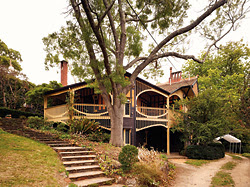 |
| N°2 Archival image showing the three Desbrowe-Annear houses at The Eyrie. | N°3 Entry elevation, showing the restored colour palette. The garden is affected by drought. |
Further investigation of scrapings revealed a rich colour palette throughout the building exterior. Local Council planning approval was obtained to paint the house in its true colours. The other two houses have been found to share the same palette. Heritage Victoria is currently re-writing our Statement of Cultural Heritage Significance to take this into account.
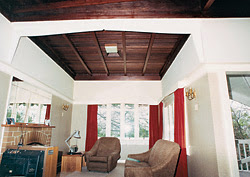 |
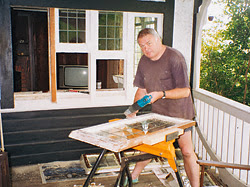 |
| N°8 The main living room as found – the lower walls covered in fibrous plaster, doors and window painted in gloss enamel, and the fireplace with brick front and mirrors above. | N°9 Peter Crone at work. Eleven sliding sashes and four hopper windows had to be removed to allow complete paint stripping. |
Living Room area
Our first project was to restore the vandalised main Living Room area.
- The original sequoia timber paneling,window brackets and fireplace surround and overmantle had been removed.
- Timber fragments found beneath the house assisted in gaining an understanding of Annear’s original detailing.
- No original drawings of the house have been discovered.
- Additionally, a considerable amount of gloss paint was stripped from all windows, doors and architraves as well as from paneling within the Entrance Hall.

This project occupied 18 months of evenings and weekends.
Window sashes
Subsequent work on the external skin of the house involved replacing 15 original window sashes where various inappropriate windows had been installed.
- Investigation within the roof spaces identified the locations within which the window sashes slid between the studwork via a system of pulleys,sash cords and brick counterweights.
- Custom made cast brass fittings were reproduced to match Annear’s original designs.
Great care has been taken to recreate the original house,at the same time adhering to the principles of the Burra Charter with new work subtly identifiable from original.
- In the re-establishment of the original bathroom and kitchen, the wall and ceiling linings have been restored, and the fit out items which provide us with the amenity of contemporary living have been designed that they may be upgraded in the future without damaging the original fabric.
- Within the pantry area which had been converted into a toilet the subsequent removal of the masonite wall lining revealed unpainted sections of original lining which provided a guide to re-installing the shelving to the original profile and in the original locations.
- The original breakfast room and the former maid’s room required substantial demolition of added layers of wall linings including hard plaster render on expanded wire mesh laid over the existing baltic wall linings as a base for ceramic tiles.
With stage one completed,we are starting to address the removal of the inappropriate billiard room addition at the rear.Meanwhile considerable ongoing maintenance ensures that the vision of Annear is preserved for future generations to experience and enjoy.
Three houses in a group of three designed by Architect Harold Desbrowe-Annear
 |
  |
 |
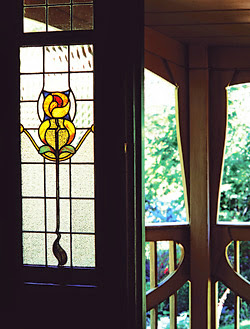 |
| N°4 Entrance verandah, with views to the east framed by the swagged ogee arch and slatted balustrade. The hopper and sash windows are seen by the door. | N°5 The leadlight has been attributed to artist Blamire Young, a friend of Desbrowe-Annear. |
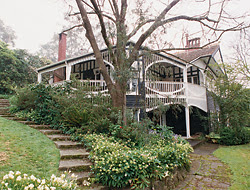 |
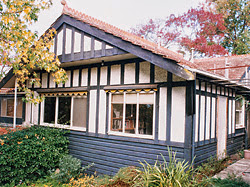 |
| N°6 The house as purchased by Peter and Jane Crone in 1988, with its black-and-white “pseudo-Tudor” colour scheme. | N°7 The north-west corner, showing the disparate windows and door added prior to the Crones’ purchase. |
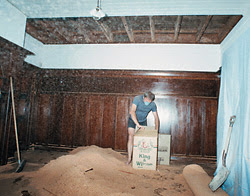 |
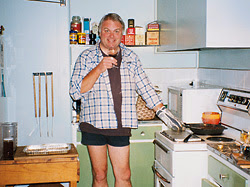 |
| N°10 Removing the false ceiling in the large downstairs room revealed the original exposed Oregon beam structure and Californian redwood lining below the upstairs jarrah floorboards. The whole ceiling area void had been packed with sawdust, possibly for insulation. | N°11 “A well deserved glass of wine after another day of toil.” The kitchen is in its 1950s state, with original windows gone and masonite covering the original timber wall lining. |
 N°12 Completed living room. The detail for the fireplace mantle came from two pieces discovered under the house and from the original backing board, found behind the mirror. The blue plaster is an exact match to the original colour, which was identified from a plaster sample and paint on top of the plate rail. |
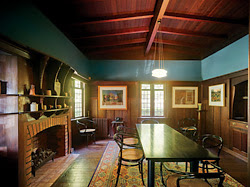  N°13 Dining room. Minimal damage made this the most original room in the house. Fireplace details matched the living room and could be used as a template. A built-in server with small hatch to the kitchen is seen to the right. |
|
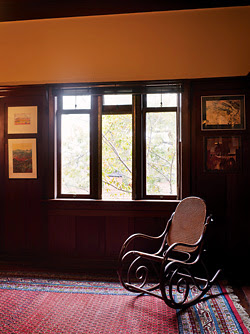 |
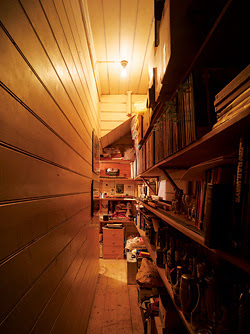 |
| N°14 Sash and hopper windows in the spare bedroom. The centre sash is open, with sash cords visible on the other windows. The lower frame of the hopper coincides with the upper sash member. Behind the rocking chair is the original brick hearth, the only clue to the fireplace. The brick arch exists behind the panelling. The mantle will be rebuilt in the future. | N°15 Lower-level storage and model making room in completely original condition. The Kauri shelving and bracket detail provided clues to shelving details in other utility areas, for example the pantry and kitchen. |
- Further investigation has revealed that the property’s other two Annear houses were painted in an identical colour scheme. Along with the Officer house, the Chadwick house has had its original Arts and Crafts colours restored. The remaining house – Annear’s own – is about to be repainted from its current black-and-white scheme.
- Crawling through the sub-floor and ceiling spaces revealed much of the history of the building. I was amazed to find that all the wall studs continued as free ends up into the ceiling space with no top plate.
- Further investigation unearthed a complete framing system that used the North American “balloon frame” method of wood construction, where long continuous framing studs run from a bearer/bottom plate with the studs tenoned into the ceiling joist line. Intermediate floor and ceiling structures are supported on offset beams checked in and nailed to the studs.
- As there are no noggings, Annear was able to utilize the modular stud spacings to accommodate operable windows – a cleverly designed offset hinged hopper window above the sash window units, which slide up into the wall cavity, counterbalanced by a common house brick in a wire cage and connected by a single sash cord threaded through a series of pulleys.
- The location of some of these pulleys in the roof space revealed the original locations of sash windows that had been replaced over the years with inappropriate alternatives. Work over the last twenty years has seen eighteen sash windows and hoppers rebuilt and installed by myself. These sashes are now complete, with the reinstatement of lost wax brass castings of all the original Annear fittings, comprising sash lifts, spring-loaded hopper catches and bell-shaped covers located over the cord knot at the top of each sash.
 |
| Architect Peter Crone’s meticulously restored home, Chadwick House in Eaglemont, Photo: Neil Newitt |
One of my early projects was to restore the fireplace mantle and walls in the main living room and entrance hall. The original sequoia (Californian redwood) panelling and window brackets, along with the entire fireplace surround and overmantle, had been removed and replaced with fibrous plaster.
- All remaining skirtings, architraves, cavity sliding doors and windows had received multiple coats of white gloss paint, which was, slowly and with a lot of patience, stripped to enable repolishing of the timber beneath.
- I was fortunate to discover sufficient lengths of twelve-foot-by-two-foot sequoia in an old timber yard that were machined to match the original profiles and thickness required for the panelling.
- Fragments of the original overmantle were discovered beneath the house, which provided clues for recreating the details.
- Work on the living room took more than eighteen months of weekends and spare evenings. Throughout our twenty years of completing stage one of the restorations, no drawings or photographs of the original house have been discovered.
- The entire internal fabric of the original kitchen and bathroom was restored, with freestanding elements inserted to provide the amenity of contemporary living. The restored walls have been left without any intrusive components. Future upgrades of equipment and services can be undertaken without affecting the fabric of the spaces. Removal of masonite wall linings in the original kitchen and pantry revealed Baltic pine lining, with painted areas defining the location of the original shelves, brackets and architraves. These were recreated in their original configuration. An internal paint colour study determined that painted timber linings and windows to the kitchen, breakfast room and study were the same cream/ochre as the external trim.
- With stage one completed, we are now starting to address the removal of the inappropriate billiard room addition (1920s) at the rear (north side) of the house, which will allow us to complete the project. Considerable ongoing maintenance will ensure that the vision of Harold Desbrowe-Annear is preserved for future generations to experience and enjoy.”
Peter Crone, LFRAIA, is the principal of Peter Crone Architects.
- Chadwick house is on the register of the National Estate as a “registered place including house and grounds”, and is also registered by Heritage Victoria and classified by the National Trust in a group classification that includes the houses and their sites, together with the landscape of The Eyrie from The Panorama to Outlook Drive.
- In 2008 the house won the Australian Institute of Architects Victorian Chapter John George Knight Award for Heritage and an Australian Institute of Architects National Award for Heritage.
|
|
Art and Craft of Living
|
|
||||
|
|
November 24, 2007 SMH Read more….
These lyrically woody houses are rare and valuable, writes Jenny Brown.
Architect Peter Crone’s passionate renovation of a rare and remarkable circa 1903 Arts and Crafts house on a remarkable site at the top of Heidelberg’s Mount Eagle (Eaglemont), has been an undertaking lasting 19 years.
- He has rebuilt 15 windows – some of which recess up into the walls – stripped some timber panelling and restored other sections.
- He has painstakingly sourced a way to copy hand-crafted brass door and window fittings and scraped back paint to reveal original colours to reinstate on interiors and exteriors. Yet . . . he’s not quite finished.
There is one side of the house still to be excavated by removing a Federation (i.e. 1919) tack-on extension.
- When that comes off, the vision of one of Melbourne’s most notable Arts and Crafts architects, Harold Desbrowe Annear, will be fully revealed in its richly detailed and lyrically woody splendour.
- The ceiling beams are Douglas fir from Oregon; the interior panels are Sequoia, from California’s giant redwoods – aged claret. “Dark, but we like it,” says artist Jane Crone.
- Their beautiful, flowing “unusually open-plan” home known as “the Chadwick House” by National Trust and Heritage Victoria, is the middle of three similar classified Arts and Crafts houses designed by Annear for himself, for his father-in-law, and for the Officer family. All share incredible north-eastern views to the Dandenongs.
|
|
||||
|
|
Peter Crone has his now-practiced eye for the way one of his architectural heroes crafted unique houses on a new project to restore another Annear house. It will be another mightily protracted renovation, yet he has already started in with a crowbar.
- Last year, his mother-in-law Margaret Bennett bought Annear’s own home, the one just up the hill and the first thing Crone uncovered was the architect’s studio on the lower floor. He broke unsympathetic add-on bathrooms and bedrooms to reveal the bones of the big square room in which Annear worked 100 years ago. “Quite unique. Wonderful,” he marvels.
- It’s an understatement when it comes to describing Arts and Crafts houses in any respect. They resulted from an aesthetic movement – born initially in Britain in the late 1800s but a movement that found expression in many Western countries – as a reaction against the mass production of the industrial era.
- It was a return to craft and the aesthetic of the hand-made item that was chosen for beauty and made to last.
Chadwick House, 32-34 The Eyrie, was designed in 1904 by the architect Harold Desbrowe Annear for his father-in-law, James Chadwick. The house is a two-storey, Medieval inspired Arts and Crafts style building with half-timbered roughcast walls, a hipped and gabled Marseilles-patterned tile roof, arcaded chimney stacks and cantilevered gables. Internally the house has extensive timber panelling with built-in furniture and storage space.
|
|
||||
|
|
||||
|
|
Chadwick House has the half-timbered rough- cast walls the hipped and gabled marseilled-pattern tile roof arcaded chimney stacks and cantilevered gables.The swagged and ogee-arch slatted balustrading to its balconies and the overall picturesque disposition of elements have been borrowed from northern European 14th and 15th century domestic styles.
The artisan ethos is evident in everything to do with Arts and Crafts.
From the choice of materials; wood, brass, leadlight, lathe plaster, stippled walls containing plastered lumps of coal, turned joinery in organic shapes, to the merest details such as brass latches, hinges and catches.
- In two hours spent touring the two houses; opening and examining every bit of ingeniously inbuilt furniture and investigating every utilised nook under the stairs, Peter Crone could point to the endless details of one-off creativity that are always functional and beautiful in their honesty. “It’s all about the detailing,” he says.\
- His admiration for Annear’s expression of Arts and Crafts Australian-style never flags. “Everything about these houses is considered individually. Just fabulous. He was brilliant,” he says. “He thought of everything.”
Arts and Crafts houses in Victoria are relatively rare.
“We’ve lost a few,” says Tracey Avery, conservation co-ordinator with the National Trust. “Comparatively few were built in Australia. In Victoria, they were built in the country, in the Western District, and in the wealthier suburbs of Toorak, Parkville, East Melbourne, Caulfield and eastern suburbs.”
- There are five in Heidelberg. The best local Arts and Crafts properties were by Annear, Robert Haddon and Walter Butler.
- The houses concentrate in the 19th century red-brick wealth belts because all the fine detail made them expensive to construct, she says. “They rarely come up on the open market and are so special, they are hard to value.”
- As real estate they are actually in such an exceptional category that she is happy to use the words “priceless” and “irreplaceable”. And for that, Ms Avery can’t emphasise enough that they are housing stock that should be so valued by their owners that they are treated with kid-gloves
“If you have one of these houses, like Peter Crone, research the architecture and live with them before you alter them. In that way you’ll discover how practical they are. The interiors have an enduring beauty and simplicity that already fits in well with modern living. The built-in furniture is as practical today as it was 100 years ago.”
- Sought after yet rare indeedand often, characteristically on big blocks. Scott Patterson, director of Jellis Craig Hawthorn, says Arts and Crafts houses often preside in the centre of overly large blocks that are hard to subdivide. He sold one, set on an enormous site this year in Canterbury for more than $2.7 million.
- “Magnificent. Beautiful proportions and with rooms that flowed into each other,” he says.
- Mr Patterson says all period houses in the inner suburbs are popular but Arts and Crafts are especially prized and are easily in the $2-$3 million category “depending on land size”.

chadwick house the eyrie eaglemont south elevation she project 2003
The renewed appreciation for the style is timely
because it presents a complete contrast to mass-produced modern, minimalist interiors. Instead, Arts and Crafts houses are about the enhancement of the material fabric. “It’s known as ‘truth to material’,” Ms Avery explains. “There is a sense of the emotional connection to materials. The timber and metal. They convey a craftsmanship that people seem to really appreciate. Even the door handles are both decorative and comfortable to use.”
- Further to being enchantingly attractive, these antique homes embody some of the pioneering principals of sustainable building. “They’re also about good sustainable architecture,” says Ms Avery. “They used local materials and local craftsmen. They didn’t import mass-produced items.”
- In the two Annear houses on Mount Eagle (which unusually do have imported timbers), Peter Crone was able to point out cleverly concealed ventilation ducts in all the ceilings in all the rooms. He also showed how strategically placed windows gathered sun and cooling breezes deep into the dark-panelled rooms.
- “In terms of climate control,” said Ms Avery “they have marvellous passive ventilation. They can teach us a lot about sustainable architecture.”
So . . . Peter Crone has a bit of work on his hands but he is already rubbing them together at the prospect of tackling his mother-in-law’s restoration project. Fortunately, he loves working with wood.
- “Let me get into it,” he grins. “This will come up beautifully.”
Architect Peter Crone and Harold Desbrowe Annear ‘s Chadwick House
 |
|
| Peter Crone outside his beloved Desbrowe-Annear home, Chadwick House in Eaglemont. Photo: Eddie Jim, 9 June 2011. |
- The Harold Desbrowe-Annear Award was introduced in 1996 by The Royal Australian Institute of Architects to recognise the best residential project of the year in Victoria. It is the highest honour in the state for Residential Architecture.
- The Robin Boyd Award for Residential Architecture is an Australian architectural prize presented by the Australian Institute of Architects since 1981.
Desbrowe-Annear Talks
|
|
Two lectures on the work of Harold Desbrowe-Annear: To be held in the courtyard at Walsh Street, the former home of Mr and Mrs Robin Boyd at 290 Walsh Street, South Yarra.













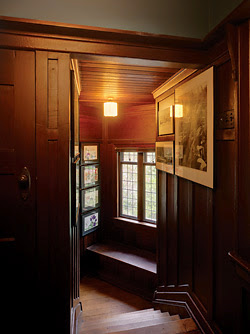









Lecture 1 – Wednesday June 15, 6.00pm for a 6.30pm start.
Harold Desbrowe-Annear: A Life in Architecture.
With Professor Harriet Edquist – academic and author of the acclaimed biography ‘Harold Desbrowe-Annear A Life in Architecture‘.
From the dustjacket:
‘Harold Desbrowe-Annear was an iconoclast and maverick:
Title: Harold Desbrowe-Annear: a life in architecture
Author(s) Edquist, H, published 2004
Publisher Miegunyah Press, Melbourne, Australia ISBN 0522850529
Summary
The projects detailed in this study include
Lecture 2 Wednesday June 22, 6.00pm for a 6.30pm start.
Peter Crone: Restoring the Chadwick House.
One of Australia’s most notable houses oh the early twentieth century the Chadwick House was recently awarded the AIA Victorian Chapter Heritage award as the culmination of 20 years painstaking research and restoration by Peter and Jane Crone.
Peter will talk about the detailed investigation of almost every aspect of the house that he and Jane undertook together with the experience and discoveries of doing most of the work themselves. It was a labour of love and celebration of craft but also an exemplary lesson in the value of heritage and good design.
Download brochure